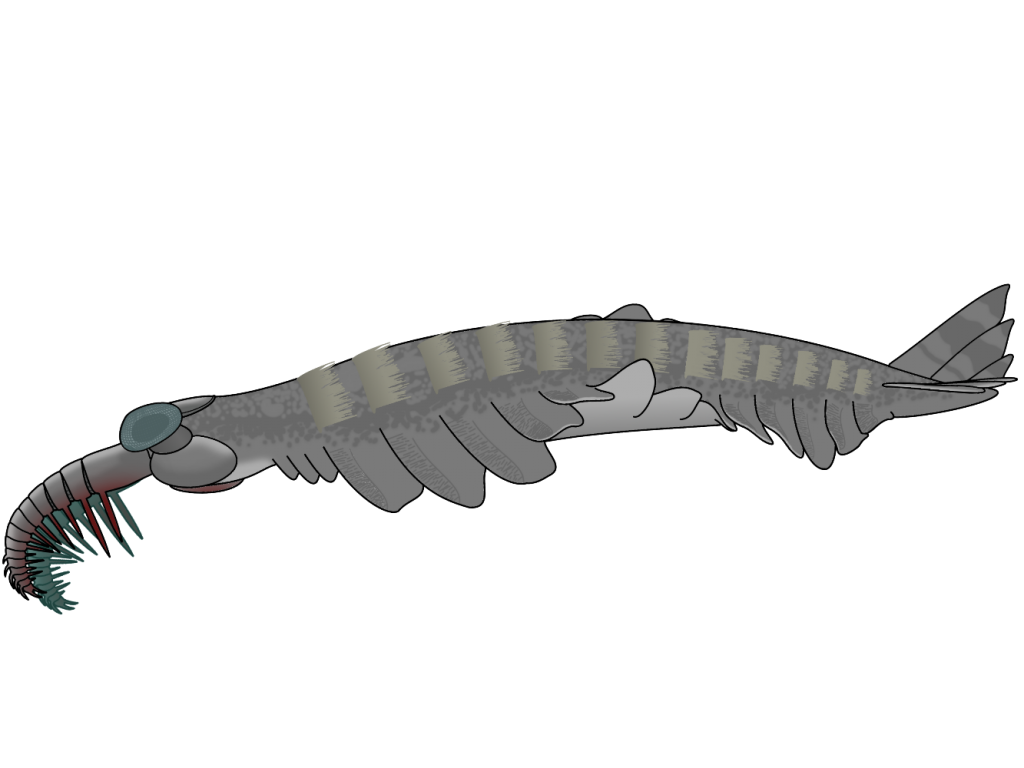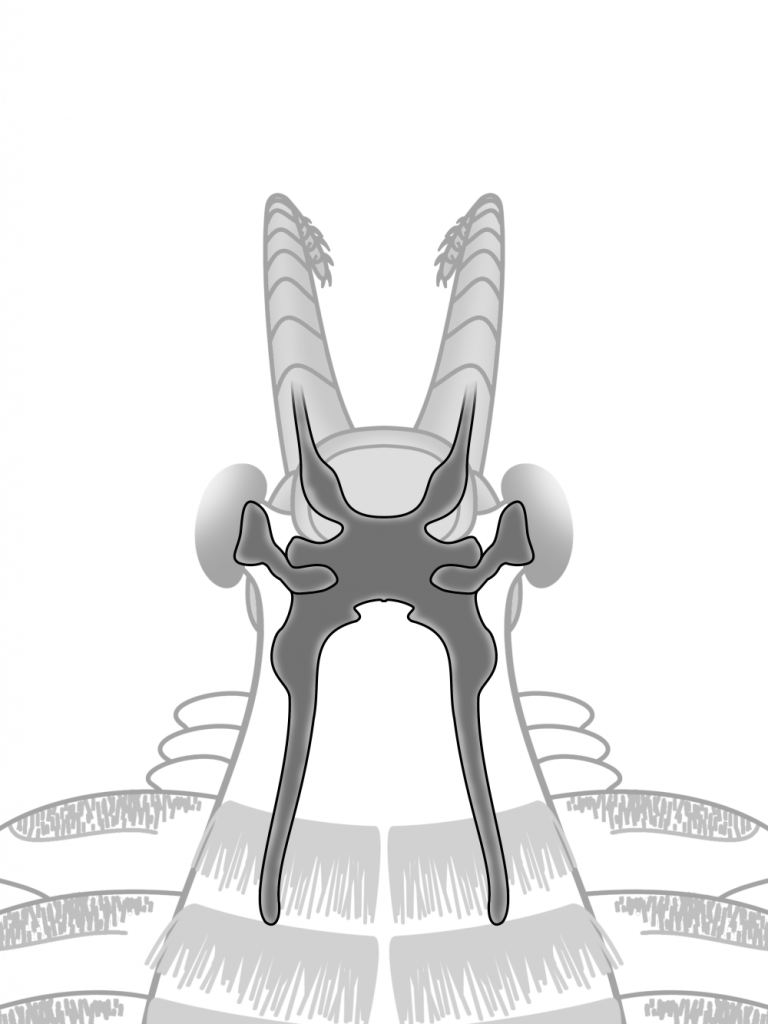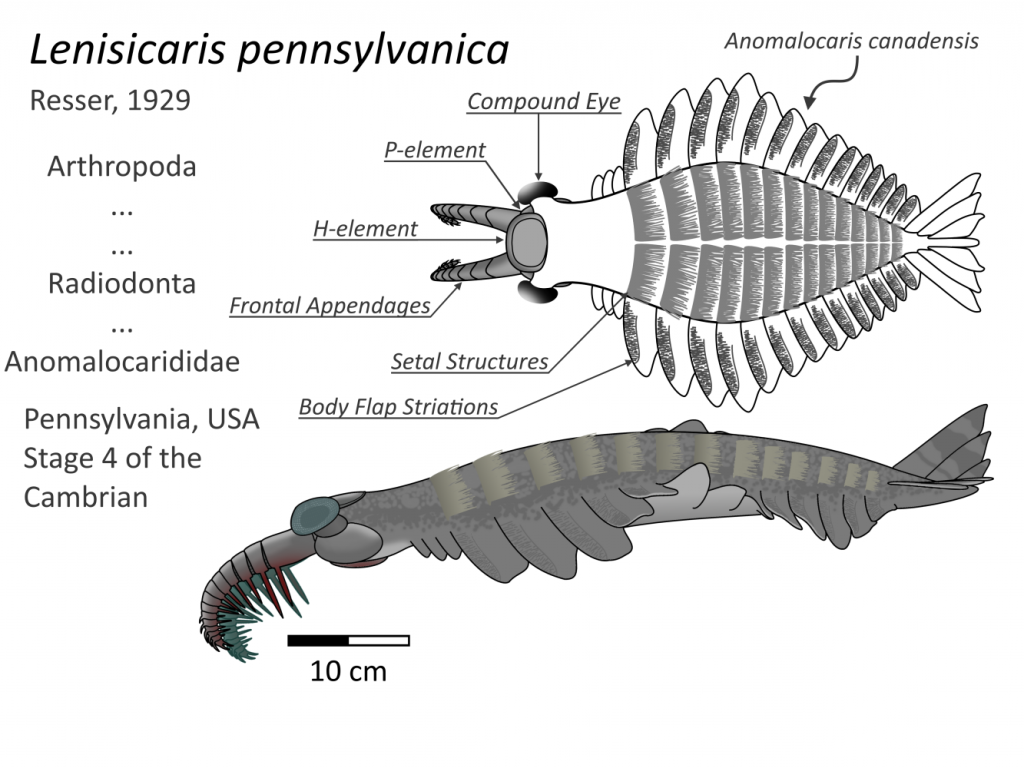
After both my previous posts in this series are nautiloid cephalopods, I thought it was time for an arthropod. Not just any arthropod, though. One that was mysterious. One that is misunderstood. A relative of a famous arthropod frequently portrayed in paleoart, but most of the time, inaccurately. This time, we’ll take a closer look at Lenisicaris pennsylvanica.
The Basics
Lenisicaris was an anomalocarid radiodont, derived early arthropods that had (for the most part) circular, radially toothed mouths behind two sclerotized frontal appendages composed of many segments, called podomeres, bearing spines called endites on their bottoms. On the sides of the head, there were stalked, compound eyes that allowed for spectacular vision. On the top of the head, there was a sclerotic plate called the H-element, with counterparts on each cheek called P-elements. The neck supported three pairs of small flaps, called lobes. These were followed by 13 segments, all bearing large lobes for swimming. At the end of he body were three dorsal lobes that formed a fan-like tail.
Lenisicaris pennsylvanica’s frontal appendage is more similar to that of Anomalocaris in form; the lengths of its endites also alternate similarly. However, Yu Wu (2021) claims that Lenisicaris pennsylvanica’s lack of auxiliary spines (spines that branch off of endites) mean it should be placed in his new genus, Lenisicaris. Not all authors agree with this, though. This species is here referred to as belonging to Lenisicaris, but this relationship may be disapproved in the future. Lenisicaris pennsylvanica’s proximal endites (those closer to the appendage’s base) are substantially longer than those of both Lenisicaris lupata and Anomalocaris canadensis. Anomalocarids are thought to have been predators, using their frontal appendages to snatch soft bodied organisms that were torn up and sucked into the mouth. Indeed, Anomalocarids seem to be adapted specifically to hunt worms.
Unfortunately, we only have the frontal appendages of both Lenisicaris lupata and Lenisicaris pennsylvanica. To reconstruct Lenisicaris pennsylvanica further, we’ll have to turn to its close relative, Anomalocaris canadensis – we have multiple beautifully preserved specimens!
As stated above, anomalocarids had three sclerotized plates on their heads, covering most of its surface. A large, squashed oval-shaped plate, called the H-element, protected the top of Anomalocaris’s head. This plate had a characteristic rim that is much thicker than the rest of the plate. It was covered in many small tubercles, something to keep in mind for high-detail reconstructions. The H-element was joined by two other plates, called P-elements. These shielded Anomalocaris’s cheeks, and were connected to the front of the H-element by organic material. The P-elements were originally misinterpreted as eyes; the organic material that joined them to the H-element was thought to represent eye stalks. These plates, along with the hardened mouth and frontal appendages, made a shield to protect the head of Anomalocaris from especially dangerous prey.
In between the P- and H-elements, Anomalocaris had large eyes supported by flexible eye stalks. These eyes were enormous; they had at least 16,000 hexagonal lenses each. It is thought that they were dichromatic, meaning that instead of the three kinds of photoreceptors that we have, Anomalocaris had two and therefore couldn’t see all the colors we see. This, however, may have helped Anomalocaris hunt in low-light conditions, as fewer kinds of receptors boosts the ability to see in the dark. Anomalocaris’s vision rivaled that of modern arthropods, and was way ahead of that of animals like Opabinia.
Behind the head, on the neck, there were three pairs of small lobes. Behind these, on the trunk, there were thirteen much larger ones for swimming. The forth lobe was the longest, after that they tapered towards the tail. Anomalocaris likely swam by undulating its lobes in a wave pattern so that together they acted as one large fin. Models show that this way of swimming was incredibly stable, not needing much brain power to function. This might explain part of why radiodonts have only one brain segment, compared to the three of most arthropods.

On the upper anterior (towards the front) surface of the lobes are many fine striations divided from the rest of the lobe by a slightly curved line. Similar structures on other radiodonts have been interpreted as structural support and veins. However, the morphology of Anomalocaris’s striations are morphologically different, on the surface of the lobes, so we don’t know what they were for.
On the dorsal surface of Anomalocaris’s main body, bands of filaments called setal blades have been found. These have been shown to be homologous with the exopod, or gill section of the biramous (“two branched”) limbs sported by some early arthropods, trilobites, and crustaceans. Similarly, the swimming lobes of radioidonts are homologous with the walking legs of euarthropods, arthropods with completely hardened exoskeletons (this includes the arthropods people usually talk about). The setal structures were likely similarly used for respiratory purposes, backed up with other research as well.
Behind the swimming lobes were three final segments that all bore lobes that formed a wide tail fan. These lobes were wide and had a big impact on swimming. Studies have shown that they could have been used very similarly to the tails of modern birds.
Reconstruct!
Now that we know the morphology of Anomalocaris canadensis, we can get an idea of what Lenisicaris pennsylvanica looked like. We know that its frontal appendages bore no auxiliary spines. We can infer that it had eyes, P- and H- elements alike to that of Anomalocaris canadensis, and that its swimming lobes, lobe striations, setal structures, and tail fan were at the very least similar. Bringing all these pieces of evidence together, we get a reconstruction like this:

Tips for Paleoartists
| Anatomy | Traits |
|---|---|
| Frontal appendages | Similar in form to Anomalocaris canadensis, but with very long endites and no auxiliary spines. |
| H-element | Mostly oval, with very rounded corners similar to where a pentagon would have them. |
| P-element | Shaped like a rounded paddle. Connected to the H-element by organic material. |
| Eyes | Large, triangular-oval shape. Thousands of hexagonal lenses. |
| Neck | Constricted, narrower than head and trunk. Bears three pairs of small lobes without striations. |
| Trunk | Sports one pair of filamentous setal structures per segment; widest on the forth and fifth segments. |
| Lobes | Curved anterior, less so on the posterior edge. Abruptly curves toward the anterior where the lobe meets the body on the posterior side. |
| Tail fan | Wide, lobes are thin a tips and quickly grow wider. Played a big role in stabilizing and steering. |
Sources
Diet
https://gsa.confex.com/gsa/2014NE/webprogram/Paper236360.html
Frontal appendages
P- and H-elements
https://www.ncbi.nlm.nih.gov/pmc/articles/PMC5577670/
https://www.academia.edu/6947803/Morphology_of_Anomalocaris_canadensis_from_the_Burgess_Shale
Eyes
Dichromatic vision
https://web.archive.org/web/20141006111136/http:/www.perceptionweb.com/abstract.cgi?id=v060037
Nervous system
Homology in swimming lobes
https://www.nature.com/articles/nature14256
Swimming
